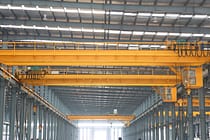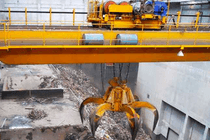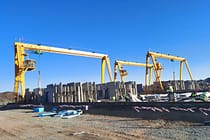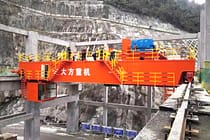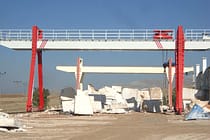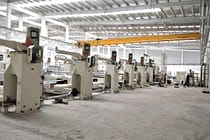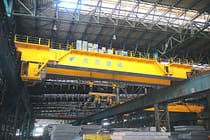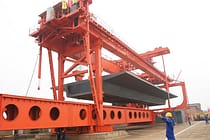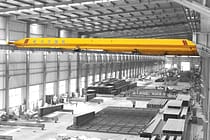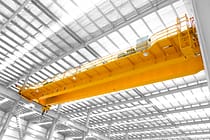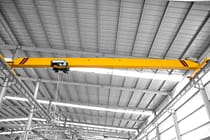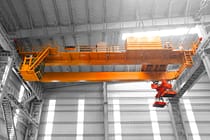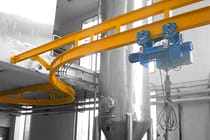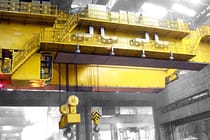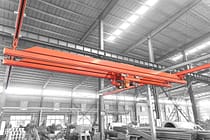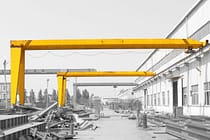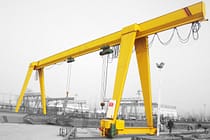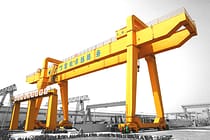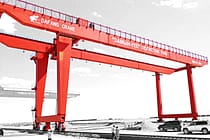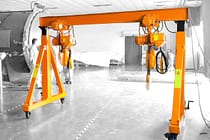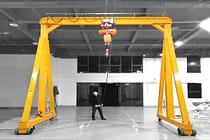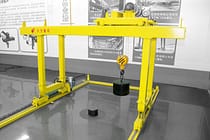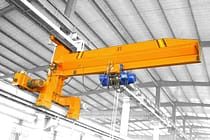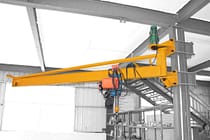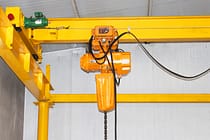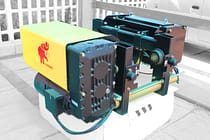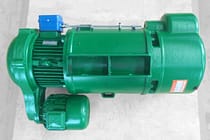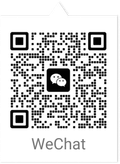Электрический козловой кран: осмотр и техническое обслуживание
Оглавление
Для обеспечения безопасной и нормальной работы козлового крана с электротельфером и продления срока службы его компонентов, деталей и самого крана необходимы регулярные осмотры и техническое обслуживание. В этой статье подробно объясняется периодичность осмотра и технического обслуживания каждой детали крана, а также конкретные этапы этих процедур. Надеемся, это руководство окажется вам полезным.
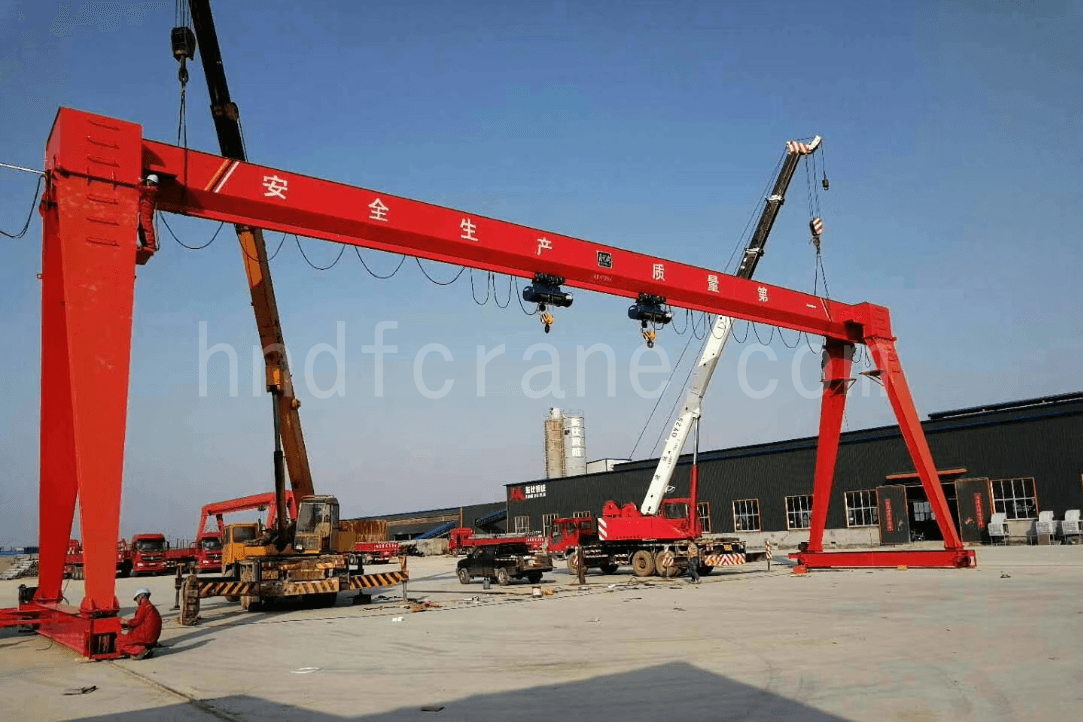
Ежедневный осмотр
Ежедневная предэксплуатационная проверка
- Осмотр должен проводиться оператором; ремонт должен осуществляться назначенным персоналом по техническому обслуживанию.
- Проверьте, нет ли препятствий в рабочей зоне и свободен ли маршрут транспортировки; работа не допускается до тех пор, пока все проблемы не будут устранены.
- Проверьте рельсы на наличие масла, воды или мусора. Для наружных кранов проверьте наличие грязи, льда или снега. Перед началом работы удалите все загрязнения и препятствия.
- Проверьте, может ли кран свободно двигаться во всех направлениях без нагрузки. Если нет, немедленно отремонтируйте.
- Проверьте чувствительность и надёжность работы тормозной системы и других устройств безопасности. При обнаружении каких-либо проблем немедленно устраните их.
- Проверьте исправность систем подъёма и управления подъёмом. Если нет, немедленно отремонтируйте.
Ежедневный осмотр во время эксплуатации
Во время работы оператор должен постоянно следить за любым из следующих отклонений. При их обнаружении немедленно прекратить работу и сообщить об этом обслуживающему персоналу. Возобновлять работу можно только после устранения проблемы.
- Аномальные вибрации, удары, раскачивание или тряска во время работы.
- Необычные шумы или чрезмерно громкие звуки.
- Сильное соскальзывание крючка.
- Сильное проскальзывание тележки или крана.
- Сильный перекос или закусывание рельс.
- Любые другие ненормальные состояния.
Ежедневный осмотр после операции
После завершения работы оператор должен провести плановые проверки техники безопасности и сообщить оператору следующей смены устно или письменно о любых проблемах. При необходимости ремонта оператор следующей смены должен сообщить об этом обслуживающему персоналу. Возобновить работу можно только после завершения ремонта.
- Проверьте надежность креплений в точках соединений.
- Проверьте наличие перегрева в двигателях, электрических системах и редукторах.
- Проверьте наличие утечек масла в редукторах или в местах расположения масляных уплотнений.
- Проверьте износ открытых частей, таких как тросы и колеса.
- Проверьте наличие электрических опасностей, таких как оголенные провода или утечка тока.
- Осмотрите корпус крана на предмет коррозии.
- Если кран установлен на открытом воздухе, проверьте, нет ли скопления воды, снега или льда на корпусе крана.
Ежедневные задачи по обслуживанию
Задачи по техническому обслуживанию, выполняемые оператором
- Регулярно очищайте окна кабины оператора.
- Регулярно производите уборку кабины, проходов, лестниц и других помещений.
- Регулярно удаляйте пыль и мусор из двигателей, электрических компонентов, редукторов и корпусов подшипников.
- Регулярно очищайте рельсы от мусора, снега и льда.
Проблемы, о которых оператор должен сообщать обслуживающему персоналу
- Нанесите смазку и очистите открытые поверхности трения во время движения.
- Перекрасьте участки с отсутствующей или отслаивающейся краской.
- При необходимости установите дождевики.
- Проверьте электрические кабели и провода на предмет старения или трещин, чтобы избежать поражения электрическим током или короткого замыкания.
Ежемесячная проверка
Общая производительность оборудования
| Элемент | Частота | Содержание и требования |
|---|---|---|
| Испытание на шум машины | Раз в 3 месяца | Используйте шумомер (децибеллометр) для измерения уровня шума при подъёме, опускании и перемещении. Шумомер действует как стетоскоп, выявляя и анализируя аномальные условия по уровню шума. |
| Осмотр с полной нагрузкой | Раз в 3 месяца | Визуально осмотрите основную балку или груз на предмет ненормальной вибрации при подъёме с полной нагрузкой; прислушайтесь к необычным звукам работы механизмов; по возможности ощупайте редукторы и двигатели для выявления перегрева. Проанализируйте и устраните любые отклонения. |
| Проверьте, когда автомобиль полностью опущен и имеет полную загрузку. | Раз в 3 месяца | При опускании груза с полной нагрузкой остановите подъёмник и проверьте величину проскальзывания. Если проскальзывание чрезмерное, отрегулируйте зазор тормоза подъёмного механизма до восстановления надлежащего торможения. |
| Проверка перемещения подъемной тележки | Раз в неделю | Обратите внимание на наличие затруднений при подъёме тележки, проскальзывания, подвешивания колёс, заедания рельсов или заноса фланцев. При наличии подобных проблем проверьте жёсткость главной балки, чистоту поверхности рельсов и точность сборки тележки. |
| Проверка тормозов крана | Раз в неделю | Проверьте, нет ли заметной асинхронности при движении и торможении. Если да, отрегулируйте зазор основного тормоза тележки. Желательно, чтобы регулировку обоих тормозов выполнял один и тот же человек, чтобы обеспечить одинаковое ощущение руки. |
| Проверка рабочего состояния крана | Раз в неделю | Во время работы проверяйте наличие аномального змеевидного движения, скручивания, бокового скольжения, перекоса, заедания рельсов или необычных шумов. Запишите результаты и выясните причину. |
| Проверьте тормоз в работе крана. | Раз в 3 месяца | Проверьте чувствительность ходового тормоза, убедитесь, что он не останавливает кран и имеет слишком большой путь скольжения. |
| Проверка баланса нагрузки на колеса (феномен трех ножек) | Раз в 3 месяца | Обратите внимание на то, подвешено ли какое-либо из четырех колес крана, или демонстрирует ли какое-либо колесо частичное вращение или отсутствие вращения во время работы, что указывает на феномен «трех ног». |
| Проверка на утечку | Раз в 3 месяца | Проверьте наличие утечек масла в редукторе подъема и редукторах тележки/ходовой части. |
| Проверка внешнего вида поверхности и качества | Раз в 6 месяцев | Осмотрите поверхность крана на предмет наличия ржавчины, отслоения краски или физических повреждений. |
Инспекция крановых рельс
| Элемент | Частота | Содержание и требования |
|---|---|---|
| Осмотр беговой дорожки | Раз в неделю | Проверьте наличие препятствий в зоне перемещения. Убедитесь, что зазор между краном и верхней частью и боковыми стенками здания не слишком мал. Также проверьте наличие опасностей, которые могут привести к столкновению с лампами, трубками в здании или близостью к оголённым медным проводам. |
| Проверка концевого стопора | Один раз в три месяца | Проверьте торцевые упоры на предмет деформации, повреждений или риска отсоединения. Если они закреплены болтами, проверьте крепление на предмет ослабления; если они сварные, осмотрите сварные швы на наличие трещин. |
| Контроль деформации рельсов | Один раз в полгода | Осмотрите рельс в вертикальном и горизонтальном направлениях на предмет ненормального изгиба или деформации, выходящих за пределы допусков установки. |
| Проверка установки рельс | Один раз в полгода | Проверьте наличие деформации на стыках рельсов, ослабления крепёжных болтов, бокового смещения рельсов и трещин в сварных швах. Также проверьте люфт в прокладках и соединительных пластинах. |
| Проверка износа рельсов | Один раз в полгода | Осмотрите поверхность катания и боковые поверхности рельсов на предмет чрезмерного локального износа. Для двутавровых рельсов проверьте поверхность катания и торцы на предмет отслоения, износа или деформации. |
Проверка главной и концевой балки
| Элемент | Частота | Содержание и требования |
|---|---|---|
| Проверка сварных швов основных и концевых балок | Один раз в полгода | Проверьте, нет ли трещин в сварных швах на главной балке и концевых балках. |
| Проверка износа и деформации главной балки | Один раз в полгода | Проверьте проступь полки двутавровой балки и боковые поверхности главной балки на наличие сильного износа или пластической деформации (провисание полки). |
| Проверка соединений главной и концевой балки | Один раз в полгода | Если основная и концевая балки скреплены болтами, проверьте, не ослаблены ли болты. |
| Проверка рельс на главной балке | Один раз в полгода | Для рельсов опорного типа, установленных на главной балке, проверьте наличие ненормального изгиба или деформации. Проверьте затяжку рельсовых зажимов и болтов, а также осмотрите сварные швы на наличие трещин. |
| Проверка концевого упора тележки на главной балке | Один раз в три месяца | Проверьте, не деформированы ли, не повреждены ли и не грозит ли падение концевые упоры тележки на главной балке. Проверьте, не ослаблены ли болты и нет ли трещин в сварных швах. |
| Проверка буферов на главных и концевых балках | Один раз в полгода | Ударные буферы, установленные на концевых упорах главной балки и концах концевых балок, должны быть надежно закреплены. Проверьте, нет ли ослабленных болтов, трещин, сколов или повреждений на буферах. |
Проверка двигателя
| Элемент | Частота | Содержание и требования |
|---|---|---|
| Проверка двигателя на перегрев | Один раз в три месяца | Проверьте, не перегреваются ли двигатели подъёма и передвижения. Если да, определите, являются ли причиной перегрева чрезмерная перегрузка, колебания напряжения, частые пуски и остановки, слишком малый зазор тормоза или ненормальное трение между тормозным колесом и тормозным кольцом. |
| Проверка исправности двигателя | Один раз в три месяца | Проверьте, запускаются ли двигатели подъёма и передвижения с трудом, издают ли они слишком много шума или ненормальные звуки. Проанализируйте, являются ли причиной чрезмерная перегрузка, низкое напряжение питания, неполное отпускание тормоза или ненадёжные/слабые соединения проводов. |
Проверка тормозов
| Элемент | Частота | Содержание и требования |
|---|---|---|
| Проверка состояния износа | Один раз в полгода | Для двигателей с коническим тормозом откройте крышку двигателя, чтобы оценить степень износа конического или плоского тормозного кольца. Вручную протолкните крыльчатку вентилятора в осевом направлении, чтобы проверить осевой люфт; чрезмерный осевой люфт указывает на сильный износ. Осевой люфт не должен превышать 4 мм и должен быть отрегулирован до 1,5 мм. В противном случае тормозное кольцо необходимо выбраковать и заменить. Плоские или колодочные тормозные материалы следует заменять, когда износ достигает 50% от исходной толщины. |
| Проверка эффективности тормозов | Один раз в полгода | Проверьте, эффективно ли тормоз подъёмного механизма останавливает груз при опускании. При чрезмерном проскальзывании немедленно отрегулируйте эффективность тормоза. |
| Проверка на наличие отклонений | Один раз в полгода | Проверьте, не ослаблены ли стопорные гайки каждого тормоза (для конических тормозов). Осмотрите износ шарниров в рычажном механизме электромагнитных колодочных тормозов и проверьте, не ослаблена ли пружина. Если при торможении слышен скрежет, проверьте относительное трение или плохой контакт между тормозным колесом и тормозным кольцом (колодкой или колодкой), а также проверьте, не деформирована ли пружина. |
Проверка редуктора
| Элемент | Частота | Содержание и требования |
|---|---|---|
| Проверка шума зубчатой передачи | Один раз в полгода | Проверьте, не издают ли шестерни каждого механизма посторонний шум. Определите, вызван ли посторонний шум недостаточной смазкой, сильным износом шестерён или подшипников, повреждением поверхности шестерён или неточной обработкой и сборкой шестерён. |
| Проверка на наличие отклонений | Один раз в полгода | Проверьте затяжку соединительных или крепёжных болтов каждого редуктора и отсутствие утечек масла. Проверьте корпус редуктора подъёма на наличие трещин, вызванных ударом крюка при повороте, возможно, из-за выхода из строя ограничителя подъёма. |
Проверка барабана
| Элемент | Частота | Содержание и требования |
|---|---|---|
| Проверка состояния износа | Один раз в полгода | Проверьте состояние канавок для троса на барабане. Обратите внимание на наличие ненормального износа. |
| Проверка оболочки барабана | Один раз в полгода | Проверьте, нет ли на оболочке барабана вмятин или повреждений, особенно тех, которые образовались из-за удара шкива крюка по оболочке при выходе из строя ограничителя подъема. |
| Проверка направляющей каната | Один раз в полгода | Проверьте направляющую троса на наличие трещин и убедитесь, что трос может беспрепятственно проходить через выходное отверстие направляющей троса при опускании пустого крюка. |
| Проверка на наличие отклонений | Один раз в полгода | Проверьте, не ослаблена ли пластина прижима троса к барабану, не ослаблены ли болты соединения барабана или болты крепления направляющей троса, а также плавно ли перемещается направляющий ползун внутри направляющей троса. |
Инспекция стальных канатов
| Элемент | Частота | Содержание и требования |
|---|---|---|
| Проверка оборванных проводов | Раз в неделю | Проверьте, нет ли оборванных проволок на канате. Если количество оборванных проволок на одной свивке превышает 10% от общего числа проволок, канат подлежит браковке. |
| Проверка состояния износа | Раз в неделю | Уменьшение диаметра каната вследствие износа не должно превышать 7% номинального диаметра. В противном случае канат подлежит списанию. |
| Проверка деформации | Раз в неделю | Канаты, раздавленные или перекрученные в результате наклонного подъема, подлежат утилизации. |
| Проверка на коррозию | Раз в неделю | Поверхность троса должна быть свободна от коррозии и должна удерживать необходимое количество смазки, без излишней грязи. |
| Проверка на наличие неисправностей в воздухе | Один раз в три месяца | Обратите внимание на то, не перекручивается ли трос из-за того, что его не ослабили при связывании, что может привести к внутреннему напряжению или перекосу. |
| Проверка на наличие отклонений | Раз в неделю | Регулярно осматривайте критически важные рабочие и безопасные участки троса. Убедитесь, что все точки крепления троса надёжны. Проверьте наличие достаточной смазки и отсутствие заедания троса в точках контакта с блоками или шкивами. |
Проверка крюков и шкивов
| Элемент | Частота | Содержание и требования |
|---|---|---|
| Проверка на наличие трещин | Раз в неделю | На крюке, блоке или оболочке блока не должно быть никаких опасных трещин. |
| Проверка состояния износа | Раз в неделю | Не должно быть никаких следов ненормального износа на отверстии крюка или в канавках шкивов. |
| Проверка на наличие отклонений | Раз в неделю | Проверьте шкив на наличие повреждений, незакрепленную гайку-крючок, ослабленные болты на корпусе, перегородке или пластине вала перегородки, а также ослабленные болты на балансировочном шкиве. |
| Проверка деформации | Раз в неделю | Отверстие для крючка не должно иметь никаких ненормальных деформаций. |
| Проверка ротации | Один раз в полгода | Проверьте, могут ли крюк и шкивы вращаться свободно и плавно. |
Проверка колес крана
| Элемент | Частота | Содержание и требования |
|---|---|---|
| Проверка износа | Один раз в полгода | Протектор и внутренняя поверхность фланца колеса не должны иметь следов ненормального износа. |
| Проверка на наличие трещин | Один раз в полгода | Поверхность колеса не должна иметь аномальных трещин и повреждений. |
Проверка приводного вала и муфт
| Элемент | Частота | Содержание и требования |
|---|---|---|
| Проверка деформации | Один раз в полгода | Проверьте приводной вал на предмет деформации, вибрации или других аномальных явлений. |
| Поддержка инспекции | Один раз в полгода | Проверьте, не ослаблены ли болты крепления опор приводного вала, а также состояние подачи масла. |
| Проверка работы муфты | Один раз в полгода | Проверьте степень износа, состояние крепления и рабочее состояние муфты на наличие отклонений. |
Осмотр кабины оператора
| Элемент | Частота | Содержание и требования |
|---|---|---|
| Проверка фиксированного состояния | Один раз в полгода | Проверьте, не ослаблены ли болты крепления кабины; если кабина сварная, проверьте, нет ли трещин в сварных швах. |
| Проверка условий труда | Один раз в полгода | Убедитесь, что вентиляция, отопление и освещение работают нормально и исправно; проверьте, не трясется ли кабина слишком сильно. |
Проверка заводской таблички
| Элемент | Частота | Содержание и требования |
|---|---|---|
| Проверить видимость | Один раз в полгода | Проверьте, является ли расположение таблички с данными о тоннаже разумным и очевидным. |
| Проверить фиксированное состояние | Один раз в полгода | Проверьте, не ослаблены ли болты или заклепки на табличке тоннажа и заводской табличке. |
Введение в блок питания. Проверка устройства.
| Элемент | Частота | Содержание и требования |
|---|---|---|
| Проверка безопасности неизолированного токосъемного провода | Один раз в три месяца | Проверьте, соответствует ли безопасное расстояние между неизолированным тросом крана и окружающим оборудованием нормам, а также приняты ли соответствующие меры безопасности. |
| Поверхность контроля проволочного слайда | Один раз в три месяца | Осмотрите скользящую контактную поверхность токосъемного провода на предмет коррозии или ржавчины; используйте проволочную щетку или наждачную бумагу для своевременной очистки, чтобы обеспечить проводимость. |
| Изоляционное устройство | Один раз в три месяца | Не допускается наличие повреждений на опорных изоляторах токосъемного провода, соединительные детали не должны иметь ослабленного крепления. |
| Проверка устройства ввода кабеля | Один раз в три месяца | Проверьте износ и натяжение натянутого стального троса, поддерживающего кабель, при использовании устройства для ввода кабеля. |
| Проверка метки безопасности скользящей проволоки | Один раз в полгода | Проверьте, имеется ли на контактной поверхности токосъемника со стороны, не контактирующей с проводником, защитная маркировка, а также индикаторная лампа, показывающая состояние питания. |
Проверка токосъемника
| Элемент | Частота | Содержание и требования |
|---|---|---|
| Проверка состояния износа | Один раз в полгода | Проверьте состояние износа шкива токосъемника, вала штифта или подвесного кольца; недопустимый износ. |
| Проверка фиксированного состояния | Один раз в полгода | Соединительные болты между токосъемником и кабелем не должны быть ослаблены; изоляторы и крепления должны быть безопасными и надежными. |
| Блок токарной проверки состояния токосъемника | Один раз в три месяца | Шкив токосъемника должен вращаться гибко и плавно; если возникает шум трения или затруднение вращения, немедленно смажьте его. |
| Проверка пружины токосъемника | Один раз в полгода | Пружины токосъемника должны сохранять хорошую эластичность без ржавчины и усталости. |
Проверка проводки
| Элемент | Частота | Содержание и требования |
|---|---|---|
| Проверка поверхности проводки | Один раз в три месяца | Проводка от токосъемника к двигателю и электроприборам (внутренняя проводка), включая резиновые мягкие кабели, не должна иметь внешних повреждений. |
| Проверка фиксированных соединений | Один раз в полгода | Все электрические крепежные болты и болты крепления внутренней проводки не должны быть ослаблены; кабельные каналы должны быть надежно закреплены на корпусе машины. |
| Проверка производительности удлинителя плоского кабеля | Один раз в полгода | Проверьте, нет ли трудностей с вытягиванием или сворачиванием плоского кабеля из-за материала или старения; гибкость не должна ухудшаться. |
| Проверка удаления кабеля | Один раз в три месяца | Проверьте, не имеет ли мягкий кабель, используемый в качестве входа питания, ненормальных изгибов или скручиваний во время движения. |
Проверка электромагнитного контактора
| Элемент | Частота | Содержание и требования |
|---|---|---|
| Контактная и сердечниковая инспекция | Один раз в три месяца | Откройте электромагнитную распределительную коробку; проверьте контакты и сердечник на предмет ненормального износа или повреждений; торец сердечника должен быть ровным и чистым. |
| Проверка состояния фиксированной электропроводки | Один раз в полгода | Проверьте, не ослаблены ли болты крепления проводки. |
| Проверка работы контактора | Раз в неделю | Работа должна быть чувствительной и надежной; контакты должны быть плотными, без заеданий и заеданий. |
Осмотр подвески
| Элемент | Частота | Содержание и требования |
|---|---|---|
| Осмотр внешнего вида | Раз в неделю | След от кнопки должен быть очевиден, а на подвесном выключателе не должно быть никаких повреждений. |
| Проблемы Аномальная инспекция | Раз в неделю | Соединительная часть между подвесным пультом управления и концом кабеля не должна иметь повреждений, а также не должно быть проблем, таких как обрыв провода. |
Проверка концевого выключателя подъема
| Элемент | Частота | Содержание и требования |
|---|---|---|
| Проверка действий | Раз в неделю | Проверьте, является ли действие концевого выключателя подъема чувствительным, безопасным и надежным. |
| Проверка контактной точки | Один раз в три месяца | Проверьте контакты переключателя на предмет повреждений или поломки; в целях безопасности немедленно замените их, если они серьезно повреждены или изношены. |
| Проверка состояния фиксированной электропроводки | Один раз в полгода | Проверьте, не ослаблены ли болты крепления проводки. |
| Проверка положения интервала | Раз в неделю | При подъеме крюкового полиспаста в крайнее верхнее положение должен немедленно сработать концевой выключатель подъема; расстояние между самой высокой точкой крюкового полиспаста и самой низкой точкой барабана должно быть не менее 150 мм. |
Ежегодная проверка
Инспекция рельсов подкранового пути
| Элемент | Стандарт |
|---|---|
| Чистота поверхности катания рельсов | Никакой прилипшей жирной грязи или большого количества грязи. |
| Осмотр рельсовых путей | Рельс подшипникового типа: S ≤ 10 м, ΔS = ±3 мм S > 10 м, ΔS = ±[3 + 0,25 × (S-10)] мм Рельс подвесного типа: ΔS = ±5 мм Примечание: S = пролет (м), ΔS = допуск пролета. |
| Наклон рельсовой катания | ≤ 1/1000. |
| Разница высот двух рельсов на одном участке | ≤ с/1000. |
| Разница высот подшипника одной и той же стороны рельса | ≤ Л/1000. |
| Расстояние между рельсовыми стыками | Расстояние между стыками ≤ 2 мм. |
| Проверка на трещины и деформации | Трещины и пластические деформации не допускаются. |
| Смещение железнодорожного стыка | Вертикальное и боковое смещение ≤ 1 мм. |
| Проверка усталости поверхности катания рельсов | Отсутствие сколов и усталостных повреждений на поверхности катания рельсов. |
| Износ рельсов | Рельс опорного типа: износ ≤ 10% от первоначального размера. Рельс подвесного типа: износ протектора ≤ 10%, износ по ширине ≤ 5%. |
| Проверка стационарной установки | Болтовые соединения должны быть затянуты, сварные швы не должны иметь трещин и дефектов. |
Проверка рамы крана
Проверка дальнего света
| Элемент | Стандарт |
|---|---|
| Внешний вид проверки качества дальнего света | Не допускаются повреждения или необычные деформации, степень коррозии не должна превышать 10% от первоначального размера, слой краски не должен отслаиваться. |
| Контроль качества сварочной линии | Дефекты типа трещин в сварном шве не допускаются. |
| Проверка прогиба в середине пролета главной балки | Развал △F=(1/1000~1,4/1000)с. |
| Проверка изгиба главной балки | Изгиб △Fp≤s/2000. |
| Проверка состояния износа рельсового пути электрической тали | Для рельсов главного бруса типа «двутавр» износ по поверхности катания не должен превышать 101ТП1Т от первоначального размера; износ по ширине не должен превышать 51ТП1Т от первоначального размера. |
| Деформация полки двутавровой балки | Полка двутавровой балки не должна иметь видимых пластических деформаций. |
| Проверка неподвижной установки ходового рельса | Рельсы соединяются болтами, которые не должны быть ослаблены, рельсы закрепляются сваркой, сварной шов не должен иметь трещин. |
Проверка концевой балки
| Элемент | Стандарт |
|---|---|
| Внешний вид и качество осмотра концевой балки | Не допускаются повреждения или необычные деформации, степень коррозии не должна превышать 10% от первоначального размера, слой краски не должен отслаиваться. |
| Степень отклонения расстояния между колесами | K≤3м, △K=±3мм K>3м, △K=±K/1000мм (K: базовое расстояние, △K: отклонение базового расстояния). |
Проверка ходового механизма
| Элемент | Стандарт |
|---|---|
| Осмотр передвижного двигателя | Двигатель не должен испытывать затруднений при запуске, чрезмерного шума, необычных звуков или перегрева. |
| Проверка ходового тормоза | Тормоз должен быть безопасным, надежным и гибким. При обнаружении в деталях тормоза следующих неисправностей их следует сдать в утиль: Износ трещин, тормозного кольца или тормозной колодки достигает 50% от первоначальной толщины. Деформация пружины. Износ малого вала или диаметр отверстия оси достигает 5% от первоначального диаметра. Поверхность трения тормозного колеса не должна иметь дефектов и масляных пятен. При износе толщины реборд тормозных колес до 501ТП1Т от первоначальной толщины, а шероховатости реборд до 1,5 мм их следует выбраковать. |
| Установка редуктора хода | Болты неподвижных соединений не должны быть ослаблены. |
| Внешний вид ходового редуктора | Оболочка не должна быть травмирована или повреждена. |
| Проверка качества передач | Снаряжение следует утилизировать при наличии любого из следующих условий: Трещины на шестерне. Сломанные зубы. Язвенная деформация на поверхности зуба достигает 50% поверхности зацепления или глубина достигает 15% исходной толщины зуба. Износ толщины зубьев других зацеплений достигает 25% от исходной толщины зубьев или 30% для открытых передач. |
| Проверка герметичности редуктора хода | Утечек нет. |
| Проверка ключевых соединений | Ключ не должен быть разболтан или деформирован. |
| Изношенное состояние вала | Разность диаметров катания колес не более 21ТР1Т. |
| Проверка подшипников | Проверьте наличие смазки; не должно быть повреждений и трещин. |
| Проверка масляного уплотнения | Старения не будет. |
| Проверка зубчатой муфты | Отклонить, если произошло что-либо из следующего: Потрескивает. Сломанные зубья шестерен. Износ толщины обода составляет 20% от первоначальной толщины. |
| Проверка качества поверхности колеса | Отклонить, если произошло что-либо из следующего: Потрескивает. Толщина изношенного обода колеса составляет 50% от первоначальной толщины. Прогиб толщины фланца достигает 201ТП1Т от первоначальной толщины. Соотношение толщины слоя катания колеса составляет 15% от первоначальной толщины. При скорости движения ≤ 50 м/мин округлость достигает 1 мм. При скорости движения > 50 м/мин круглость достигает 0,5 мм. |
| Разница диаметров колес с обеих сторон | Разница диаметров обода колеса ≤ 1%. |
| Изношенное состояние вала колеса | Износ должен быть менее 2% исходной шейки вала. |
| Проверка подшипников | Не должно быть никаких повреждений и трещин. |
Проверка рамы
| Элемент | Стандарт |
|---|---|
| Степень отклонения пролета (△S) | S≤10м, △S=±2мм. S>10м, △S=±[2+0,1(S-10)]мм. △Sмакс=10мм. |
| Разница диагоналей грузового моста | K≤3м, |S1-S2|≤5мм. К>3м, |S1-S2|≤6м. |
| Разница высот нагруженного колеса (△h) | S≤10м, △h=±2,5мм, 10 15 20 25 30 |
Проверка электрических подъемников
Мотор Инспекция
| Элемент | Стандарт |
|---|---|
| Повышение температуры при осмотре двигателя | Температура нагрева двигателя с изоляцией класса Е не должна превышать 115 ℃. Температура нагрева двигателя с изоляцией класса F не должна превышать 155 ℃. |
| Проверка двигателя на наличие неисправностей | Проверьте, запускается ли двигатель с трудом и слышен ли необычный звук. |
Проверка тормозов
| Элемент | Стандарт |
|---|---|
| Проверка эффективности тормозов | Тормоза должны быть безопасными, надежными и действовать гибко. |
| Проверка качества деталей тормозов | Отбраковка при наличии любого из следующих признаков: Трещины. Износ тормозного кольца составляет 50% от первоначальной толщины. Пружина имеет пластическую деформацию. Износ диаметра осевого отверстия составляет 51% от первоначального диаметра. |
| Проверка качества тормозных колес | Поверхность трения тормоза колеса не должна иметь дефектов или масляных пятен. Отбраковывайте, если обнаружено что-либо из следующего: Трещины. Износ тормозного кольца составляет 40% от первоначальной толщины, износ рабочего тормозного колеса достигает 50% от первоначальной толщины. |
Проверка редуктора
| Элемент | Стандарт |
|---|---|
| Проверка состояния установки | Соединительный болт не должен быть ослаблен. |
| Проверка качества передач | Отклонить, если произошло что-либо из следующего: Потрескивает. Зубья шестерен сломались. Поверхность коррозионной язвы составляет 50% от сопрягаемой поверхности, а глубина - 10% от источника. Допустимая степень износа первой ступени составляет 10% исходной передачи, остальных – 20%, ходовой части – 25%. Износ открытой передачи составляет 30%. |
| Проверка внешнего вида редуктора | Дефектов, как и повреждений, нет. |
| Проверка качества герметизации | Утечек нет. |
| Проверка аномалий | Запрещены ненормальные звуки и ненормальное нагревание. |
| Осмотр других частей редуктора | Любое ослабление, деформация или необычный износ не допускаются в соединении между ключом и гнездом ключа. Износ вала-шестерни должен быть менее 1% исходной шейки вала. Износ остальных валов должен быть менее 2% исходной шейки вала. Старение и метаморфозы запрещены. Запрещено выполнение бесшовных соединений на сопрягаемых поверхностях. |
Проверка барабанного устройства
| Элемент | Стандарт |
|---|---|
| Фиксированное состояние в конце проверки стального каната | Прижимная пластина на конце стального троса не должна ослабевать. |
| Проверка рабочего состояния канатного направляющего устройства | Стальной трос должен успешно высвобождаться из направляющей троса при опускании пустого крюка. |
| Проверка барабана | Отклонить, если произошло что-либо из следующего: Потрескивает. Изношенная часть стенки барабана составляет 20% от первоначальной толщины. |
Проверка шкивов
| Элемент | Стандарт |
|---|---|
| Проверка внешнего вида канавки шкива | Канавка блока должна быть гладкой и не иметь ограничений. |
| Стандарты отклонения блоков | Отклонить, если произошло что-либо из следующего: Потрескивает. Неравномерный износ канавки блока составляет 3 мм. Износ стенки канавки составляет 20% от начала. Износ дна канавки блока составляет 50% от диаметра каната. Любые дефекты повреждают трос. |
Проверка стальных канатов
| Элемент | Стандарт |
|---|---|
| Проверка качества стального каната | особые требования к лому проволоки могут быть указаны ИСО 4309-2017. |
Проверка крюка
| Элемент | Стандарт |
|---|---|
| Проверка качества крючков | Отклонить, если произошло что-либо из следующего: Потрескивает. Износ опасного сечения составляет более 101ТР1Т от первоначального размера. Открытая степень составляет более 15% исходного измерения. Деформация кручения составляет более 10% исходного размера. В опасном участке или шейке крючка происходит пластическая деформация. |
Ходовые колеса подъемника
| Элемент | Стандарт |
|---|---|
| Проверка качества колес | Отклонить, если произошло что-либо из следующего: Треск Толщина изношенного обода колеса не должна превышать 50% первоначальной толщины. Изношенная ширина должна быть больше 5% максимального диаметра оригинального колеса. |
| Предельный зазор между ободом колеса и ободом из стали I-типа | Макс. зазор должен быть не более 50% ширины катания колеса. |
Проверка электрооборудования
Проверка устройства ввода питания
| Элемент | Стандарт |
|---|---|
| Проверка безопасности оголенного направляющего провода | То же самое, что и ежемесячный осмотр. |
| Проверка скользящей поверхности | То же самое, что и ежемесячный осмотр. |
| Проверка изоляционных устройств | То же самое, что и ежемесячный осмотр. |
| Гибкое устройство ввода кабеля | То же самое, что и ежемесячный осмотр. |
| Знак безопасности осмотра направляющей линии | То же самое, что и ежемесячный осмотр. |
Инспекция коллектора
| Элемент | Стандарт |
|---|---|
| Состояние износа | То же самое, что и ежемесячный осмотр. |
| Устойчивое состояние | То же самое, что и ежемесячный осмотр. |
| Состояние вращения шкива коллектора | То же самое, что и ежемесячный осмотр. |
| Проверка пружины коллектора | То же самое, что и ежемесячный осмотр. |
Проверка проводки
| Элемент | Стандарт |
|---|---|
| Проверка внешнего вида проводки | То же самое, что и ежемесячный осмотр. |
| Устойчивое состояние | То же самое, что и ежемесячный осмотр. |
| Проверка гибкости движения | То же самое, что и ежемесячный осмотр. |
| Характеристики растяжения при осмотре плоского кабеля | То же самое, что и ежемесячный осмотр. |
Проверка электромагнитного контактора
| Элемент | Стандарт |
|---|---|
| Проверка контактной точки и железного сердечника | То же самое, что и ежемесячный осмотр. |
| Фиксированное состояние проводки | То же самое, что и ежемесячный осмотр. |
| Проверка контактора | То же самое, что и ежемесячный осмотр. |
Подвесная инспекция
| Элемент | Стандарт |
|---|---|
| Осмотр внешнего вида | То же самое, что и ежемесячный осмотр. |
| Проверка на наличие ненормальных отказов | То же самое, что и ежемесячный осмотр. |
Проверка выключателя ограничителя подъема
| Элемент | Стандарт |
|---|---|
| Проверка действий | То же самое, что и ежемесячный осмотр. |
| Проверка на поражение электрическим током | То же самое, что и ежемесячный осмотр. |
| Фиксированное состояние проводки | То же самое, что и ежемесячный осмотр. |
| Ограничить осмотр местоположения | То же самое, что и ежемесячный осмотр. |
Ввод в эксплуатацию
Тест без нагрузки
| Элемент | Стандарт |
|---|---|
| Тестовый запуск без нагрузки | Управляйте краном для движения вперёд и назад, тележкой для движения влево и вправо, а также лебёдкой для подъёма и опускания. Проверьте наличие отклонений и убедитесь, что действия соответствуют обозначениям кнопок. |
| Проверка устройства безопасности | Проверьте концевой выключатель подъема, концевой выключатель перемещения и другие предохранительные устройства, чтобы убедиться в их чувствительности, безопасности и надежности. |
Нагрузочный тест
| Элемент | Стандарт |
|---|---|
| Испытание номинальной нагрузкой | Вертикальное отклонение главной балки не должно превышать значений, указанных в нормах безопасности для различных типов кранов с тельфером. |
| Тест на перегрузку | При подъеме 125% номинальной нагрузки главная балка не должна иметь следов остаточной деформации, трещин, отслоения краски, ослабления или повреждений после разгрузки. |
| Тест динамической нагрузки | Поднять груз в 1,1 раза больше номинального в середине пролёта, выполняя только операции подъёма, опускания и передвижения крана. В течение указанного времени все механизмы должны работать плавно, гибко и надёжно, без каких-либо отклонений. |
Техническое обслуживание смазки
Все подвижные части крана, требующие смазки, необходимо регулярно смазывать. Необходимо проверять систему смазки, чтобы убедиться в бесперебойной подаче смазки. Точки смазки, периодичность и тип используемого смазочного материала должны соответствовать рекомендациям производителя. Смазку следует наносить только на неподвижном кране.
Функции смазочного обслуживания
- Контроль трения
- Уменьшить износ
- Более низкая рабочая температура
- Предотвращает ржавчину и коррозию
- Улучшение герметичности
Методы смазки
- Дисперсная смазка: с использованием масленок, пресс-масленок, смазочных пистолетов и т. д.
- Централизованная смазка
- Ручная смазка глицерином: использование масляных насосов, масленок и масляных фильтров.
- Электрическая глицериновая смазка: использование двигателей, редукторов, насосов и масляных резервуаров.
- Точки смазки в масляной ванне: Внутри корпуса редуктора.
Общие точки смазки
- Подшипники на гайке крючка
- Подшипники подвижных и неподвижных шкивов
- Канаты
- Подшипники вала барабана
- Подшипники во всех точках вращения
- Шестерни внутри редукторов
- Шестерни и муфты
- Контактные точки тормоза
- Подшипники двигателя
- Подшипники колес и т.д.
Отправить запрос
- Почта: sales@hndfcrane.com
- Ватсап: +86 191 3738 6654
- Телеграмма: +86 191 3738 6654
- Тел: +86-373-581 8299
- Факс: +86-373-215 7000
- Добавить: Промышленный район Чаннао, город Синьсян, провинция Хэнань, Китай.
 WeChat
WeChat
